Trending
Opinion: How will Project 2025 impact game developers?
The Heritage Foundation's manifesto for the possible next administration could do great harm to many, including large portions of the game development community.

Featured Blog | This community-written post highlights the best of what the game industry has to offer. Read more like it on the Game Developer Blogs or learn how to Submit Your Own Blog Post
Almost 20 years ago, Super Ghouls'n Ghosts made a tremendous use of control limitations to empower the player. Let's go back in time for a game mechanic centered analysis of this classical 1991 platformer.

In this piece, I'll take a deep look at the game mechanics of the 1991 classic platformer Super Ghouls'n Ghost released on the Super Nintendo system. I'll first be looking at the excellent implementation of the now well known “double-jump” mechanic and secondly at the different weapons and armors and how the player “gambles for power” through the game.
A quick contextualization
Environment
Let's first look at the environment in which the hero progresses. Super Ghouls'n Ghosts (SGnG) features dark level heavily filled with evil creatures. The first level gives a good idea of the pace of the game with zombies constantly growing out of the ground at random places. Weak enemies are often overwhelming in numbers, appearing randomly, though they can be killed with single shots of the weakest weapons. Stronger enemies are placed at pre-defined locations and require more hits to be killed. The important thing to keep in mind here is that the pace of the game is extreme, seldom allowing the hero to stop to take it's breath. The player's reaction time is constantly being tested. (To see the game in action, I recommend watching the “Let's Play Super Ghouls'n Ghosts” walkthrough video on youtube.)
Limiting controls
Being a platformer, two things the player does a lot in SGnG is run and jump. The hero runs at a fixed speed, meaning that as soon as the right or left key is pressed, he instantly reaches full speed. There is no acceleration or decceleration, he's either running full speed or not running at all. The implementation of the jumping mechanic is similarly limiting: pressing the jump button instantly makes the hero jump at a fixed speed and height. Jumping while holding the left or right key makes the hero jump in the respective direction, but since the running speed is fixed, the jump trajectory is always the same. On level ground the hero will always travel the exact same distance (though the ground is seldom even). The hero can change his facing direction in mid-air but not his speed. Thus, once the jump has been launched, the player will land at a predictable position no matter what he does during the jump. The space of possibilities for jumping is limited to three different jump trajectories (not taking into account environment and obstacles).
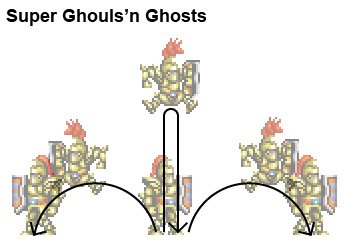
In an other popular platform game of the same era: Super Mario World, we'll see that things are quite different. In this game the player has a lot of control on the running speed and jumping height of the character. While holding the right or left keys, the hero will start slow and accelerate before reaching full speed (he can reach a greater speed if the action button is held) and he will deccelerate before stopping after the button is released. The jumping height is defined by how much time the jump button is held, allowing for a great range of jumping height (a small tap makes him jump very low, holding the button can give him a lot more height). The jumping height is also affected by the running speed; the faster he runs the higher he can jump. Also, the player can control the hero's speed in air with the right and left keys, allowing him to slightly modify the trajectory as he is jumping. These mechanics allow for a nearly infinite number of possibilities of jumping trajectories!
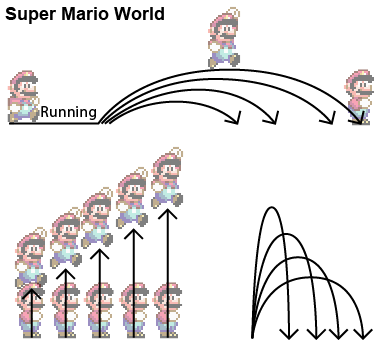
With this comparison in mind, we can easily see how the basic controls of SGnG offer a lesser space of expression to the player. However...
Introducing the double-jump!
The double jumping mechanic is the real complexity of the game's controls. It allows the hero to do a second jump while in mid-air that works the same way as the first jump (offers the same three possible trajectories). This second jump thus allows the hero to change his direction or give him more height or distance. It can also be used to reach seemingly unreachable spots (platforms located under ledges for example). The second jump is, in itself, as limiting as the first jump in it's possibilites. However, it can be performed at ANY moment during the first jump's trajectory, thus allowing an almost infinite number of possible trajectories when mixing the two jumps.
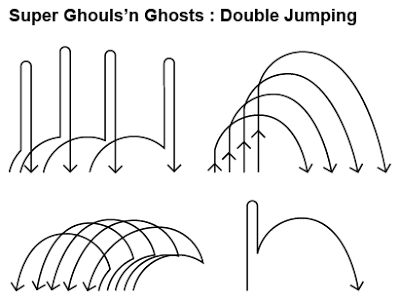
This double jumping mechanic also allowed the designers a larger range of possibilities in creating the levels, with the inclusion of platforms that would be impossible to reach with a single jumping mechanic.
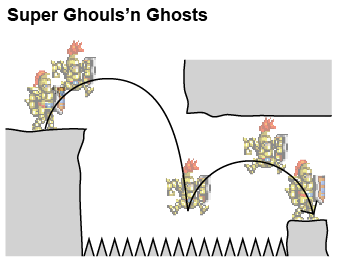
While the player has little control over the speed and the direction of each independent move, these limitations create a great predictability in the hero's movement, allowing to react much more quickly than if the hero had to accelerate and deccelerate to perform his moves. Mixed with a near infinite number of possible jump trajectories offered by the double jump mechanic, the player is given access not only to a very quick and responsive reaction time but also to a complex control scheme for his hero.
The controls in context
As previously mentioned, the pace of the game is very quick, with most levels featuring enemies constantly appearing at random places, forcing the player to stay in movement. Since jumps have a pre-defined trajectory, once a jump is started, there is a certain feeling of inevitability to the outcome. This is where the second jump is crucial. If an enemy suddenly appears in the player's trajectory, he has this second chance of saving himself from doom. However, this second jump must be well calculated. Unless the player can shoot down whatever is coming at him, he won't be able to change his trajectory until he touches the ground again. Thus, the game is constantly filled with situations that reminds us of the classic “last second” movie scene where the hero jumps out of the building as it explodes to pieces. A ghost appears in the hero's trajectory and he instantly double jumps in the opposite direction, the ghost flying on his heel, flying at the same speed until the hero finaly falls down millimeters under the ghost's path. Or the player jumps in a fatal pit to avoid some incoming projectiles falling down on him and jumps back on safe ground when the danger is passed. The player's brain is constantly pre-calculating trajectories and dangers and any small error in his calculations can potentially put him in the helpless situation of watching his hero fall down to his doom, knowing full well that he is “done for” several fractions of seconds before he really dies. This is this feeling of inevitability, in conjonction with the fast pacing of the game and the extremely responsive controls, that makes this game so satisfying. The game is hard. Very hard. But every time the hero dies, the player knows full well that it is his fault, that there was another move he could have pulled that would have saved him. And so he tries again, strengthened with an ever more acute understanding of the system.
Gambling for power
In the second part of this analysis we'll take a look at how the difficulty is balanced between the weapons and armors available in the game. The game features several weapons differing in strength, speed and ease of use. Also, each weapons possess a unique magic spell that can be used only when the player obtains the magical gold armor.
Armors
It's first important to understand how the armor system works. There is three different armors available in the game. In order of power: the silver armor, the jade (green) armor and the magical gold armor. Each armor offers the same level of protection: after a single hit they explode, leaving the hero wearing only his boxers. However, later armors enhance the weapons' power. The jade armor changes the weapon into a magical weapon, making it quicker, more powerful or bigger depending on the weapon. The gold armor offers the same change but also allows the hero to perform a magic spell that is unique to each weapon.
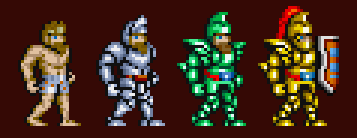
The coveted armors are found inside treasure chests hidden through the levels which appear only when the hero moves through a specific location of the level. The content of each chest is relative to the hero's current armor AND to the sequence of chests found in the level (if the player misses a chest, even if it contains only a weapon, the next one won't have the piece of armor). The player cannot find the jade armor without the silver one and cannot find the gold armor if he doesnt have the jade armor. Thus, these armors are often extremely hard to find (and do require the player to memorize the chests' locations) and are even harder to keep as they are all lost from a single hit.
Weapons
Which brings us to the weapons and their magical powers. Weapons differ greaty in their use. While a few weapons are just simple projectiles flying straight ahead, like the quick knife or the lance, others travel differently like the circular motion of the flying axe or the upward motion of the two arrows coming out the bow. On top of that, each weapon has a very different magic spell that is unlocked by the magical gold armor. The interesting part of this mechanic here is that the weapons that are the easier to handle, like the knife or the bow and arrows, offer the weakest spells of all.
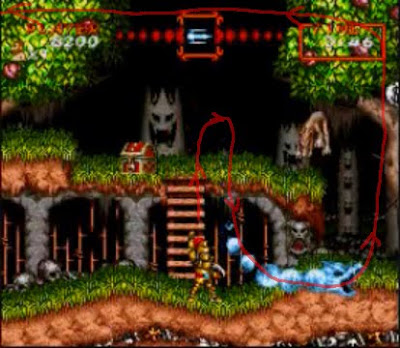
Above: the knife's dragon spell. Any enemy in the dragon's path is destroyed, though the actual path, following mostly the border of the screen, is very hard to target and pretty much fails to be useful.
On the other side, weapons like the scythe, which is very powerful but extremely slow and clumsy to use, offer the most powerful spells of all. Thus, choosing to handle a weapon like the scythe greatly increases the difficulty of the game, in comparison to using the quick and handy knife, as long as the hero has anything but the gold armor. But when he finally gets the gold armor, the power of the scythe's spell will make most enemies laughably easy to dispatch... Until he loses the armor again, that is.
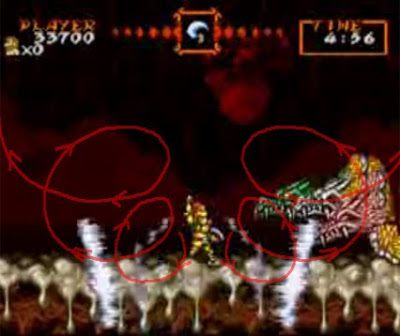
Above: The scythe's powerful spell send a huge tornado flying in a circular motion on both side of the player, wiping about 80% of the screen, possibly hitting the same enemies multiple times.
This is where the gambling spirit of the player is taken into account. The powerful weapons like the scythe and axe are much more rare than the common lances and knifes so when faced with one of these weapons, it's a matter of taking the chance to temporarily increase the game's difficulty and try to go for the hard to find gold armor or keep the safe route with the ever handy knife but sacrifice the possibility to become god-like powerful. And since these choices don't come up all that often, it makes it even more difficult to choose. (For a detailed look at the weapons and their spell, watch this extremely helpful youtube video showcasing each of the eight weapons of the games and their magical powers.) This is most interesting as it offers parallel options to the player. His choices will depend on his expertise with the game and his personality. Does he wish to gamble? Is he comfortable enough with the game? Wishing for a challenge? Or just craving for power! Most beginners will go fo the knife or even the bow (which has a globally useless spell but is very easy to use). Expert players will take more risks, not to mention renewing the game's experience and it's challenge by playing it with a different weapon.
Conclusions
Let's take a step back and look at the most important design lessons that can be learned from this analysis.
1. Movement limitations can be used to make more responsive and predictable controls. It is still possible to have complex and precise control schemes whithin these limitations by mixing together the use of two (or more) limited movements.
It's also extremely important to carefully pace the game in accordance to these limitations. The speed, power and size of the enemies must be appropriate to the speed, power and size of the hero in order to offer a fair challenge.
2. Having to choose between items that are harder to use but offer a powerful incentive versus items that are easier to use but offer less potential makes for an interesting, meaningful choice and create longer term anticipations.
Getting a better score is NOT a powerful incentive to the average player. Greed for power, as is used here, is much more interesting. Other things like getting more experience, reaching new levels or anything that change the way the game is played or offer long term advantages are preferable. This is all about the potential outcome of the decisions over instant earnings.
3. Offering options (like the use of different weapons) that can make the game either easier to play or harder and more rewarding provides ways to reach new, unexperimented players while giving an interesting replay value to expert players. (This is what Adam Saltsman call “layering” in his article about game accessibility.)
While control limitations and pacing lessons are more likely to apply to action and reflex games, balancing items, powers and rewards and offering the player different options to play the game according to his own expertise are lessons that can be easily ported and successfully applied to any kind of games. The universality of these design solutions, even almost 20 years after SGnG (1991), make them all the more worthy of our designer's attention.
References:
Read more about:
Featured BlogsYou May Also Like